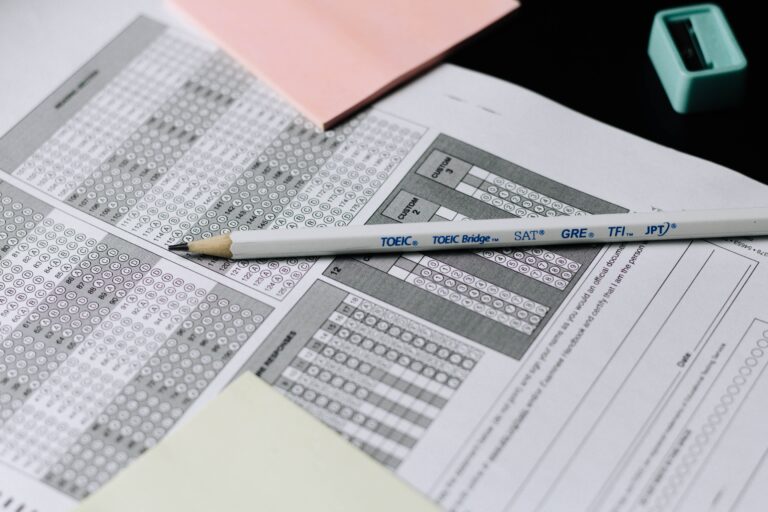Standardized Testing in a Nutshell
Grades 1-3:
Standardized testing or an alternative form of evaluation is required yearly.
Grades 4-8:
Standardized testing is required at least every other year; an alternative form of evaluation may substitute on the off years.
Grades 9-12:
Standardized testing is required yearly.
Important Information:
- Parents select the annual assessment measure (either a standardized test or an alternative form of assessment, depending on the student’s grade level) and obtain the superintendent’s consent.
- We recommend that parents indicate their selection for the annual assessment on their third quarterly report, then include the composite score results with their fourth quarterly report.
- The full list of standardized tests that can be used is available from the NY SED. (If parents selected the California Achievement Test, they are free to use any edition.)
- Sources for obtaining the standardized tests may be found at www.homeschoolnewyork.org.
- Testing should ideally be done in the child’s classroom (home) with his or her own teacher (the parent), but other options do exist. Parents may administer tests per the superintendent’s consent and are not required to be NYS certified teachers to do so.
- State-mandated tests are not required to be taken by homeschoolers.
- Homeschoolers may participate in the PSAT and SAT by contacting public or nonpublic schools. Use 993399 as the “school number” for homeschooled students on the test forms. These tests do not necessarily fulfill the end of year standardized testing requirement unless the superintendent has specifically consented to accept them for that purpose.
- The alternative form of evaluation (applicable for grades 1-3 and every other year for grades 4-8 is a written narrative prepared by a certified teacher, home instruction peer review panel, other person chosen by the parent (if consent is obtained from the superintendent), or the parent (if consent is obtained by the school district). The local school district has no authority to limit persons who may conduct the alternative evaluation as long as that person has interviewed the student and reviewed a portfolio of his or her work.
For more information, click here to download our NYS LEAH Regulatory and Informational Manual for free (or see below)!
Annual Assessment Q&A
Annual assessments tend to create some anxiety. Just relax and take some time to become familiar with what is and what is not required of you. Annual assessments are defined in the regulations under Section 100.10 (h). In reviewing this section, several questions may come to mind:
Q. Who selects the annual assessment?
A. Some districts have been known to dictate what assessment measure the parent should use. Please note that the Regulations indicate that it is the parent and not the school district who selects the annual assessment measure (test or narrative) to be used, depending upon the grade level of the child. However, the consent of the superintendent is needed before the annual assessment measure can be used.
Q. When do I notify the school district of my annual assessment selection?
A. The Regulations are not specific about when to notify the superintendent, but it is recommended that you indicate your selection for the annual assessment by the end of the third (3rd) quarterly reporting period (see question #55 in the Revised Questions and Answers from the SED). Please bear in mind, it is the composite score results of the annual assessment test or written narrative that should be filed with the fourth (4th) quarterly report. Therefore, planning for assessments should begin before the end of the third quarter. If you don’t have the test results back by the fourth quarterly report, don’t worry. Just add a notation to the report and send in the results when available.
Q. How do I notify the school district of the annual assessment selection?
A. There is no standard format to use to notify the school district. One suggestion is to include a statement with the third (3rd) quarterly report, such as:
“In accordance with Section 100.10 (h) of the Regulations of the Commissioner of Education covering Home School Instruction, please find below our annual assessment selection for (Student’s name) for the 2021-2022 school year. Annual Assessment: A written narrative on (Student’s name) prepared by (name of person preparing the report) OR (name of Standardized Test). We will assume that the above annual assessment selection meets with your consent unless we hear from you in writing by (two weeks from date on letter).
Sincerely,
Parents’ Names”
Q. Which annual assessment should I use?
A. As indicated per the regulations, the parent can choose either a standardized test or a written narrative, depending upon the grade level of the student. An alternative form of assessment (i.e. written narrative) may be used annually in grades 1-3 and every other year in grades 4-8 (in other words, if the narrative is used in grades 4 and 6, then a test must be used in grades 5 and 7). For grades 9-12, a standardized test must be used annually. At this point, there is another option available. When a child reaches the age that mandatory attendance is no longer required, parents could notify the school superintendent that although the student will continue with his education, reports will no longer be sent to the superintendent.
Q. What standardized tests can be used?
A. Several options exist. The Regulations list several standardized tests which are recognized by the state. There are other tests available which have been recognized since the Regulations were published. The full list should be available from the NY SED. The following additional tests were deemed equivalent by the Division of Educational Testing on the dates indicated for use in individual testing situations in compliance with CR 100.10:
- 6/29/90 Stanford Diagnostic Reading Test and Woodcock-Johnson tests used together
- 2/11/91 NYC math exam and DRP-PCT in reading
- 03/5/91 ERB
- 9/11/91 Peabody Individual Achievement Test-Revised
Kaufman Test of Education Achievement (brief or comprehensive form)
Woodcock Reading Mastery, Tests-Revised together with KeyMath - A Diagnostic Inventory of Essential Mathematics:
- 05/3/91 Test of Achievement and Proficiency (TAP)
- 03/6/95 PASS (Personalized Achievement Summary System) Test
Hewitt Foundation Test - Secondary Level. Tests:
Iowa Tests of Basic Skills, Forms G and H
Stanford Achievement Test Series, Eighth Edition
Metropolitan Achievement Tests 6 – Advanced 1 and 2
California Achievement Tests E and F
CTBS Forms U and V
Q. Where can I obtain the standardized tests?
A. There are several sources for obtaining tests. There is a partial listing at the back of the manual in the Resource Appendix. Sources for tests may be found on our website at www.homeschoolnewyork.org. Some testing agencies also provide practice tests and test suggestions, such as the Test Alert from Bob Jones University Testing Service. These materials are designed to familiarize the student with test-taking strategies and to strengthen test taking and thinking skills.
Q. Where can the standardized testing be done?
A. Testing should ideally be done in the child’s classroom with his own teacher. Standardization of a test includes not only the content, timing, and scoring, but the place and administrator, also. In home education, this would mean the test should be given in the home by the parent. This is not always possible because the test publisher or other factors determine who the test administrator will be. For example,
- BJU Press Testing and Evaluation has a program for training test administrators. Taking this training would enable the parent to give any of the tests provided through BJU Press T&E.
- Christian Liberty Academy Testing Service has the publication rights to the 1970 edition of the California Achievement Test. Parents can administer this test at home themselves.
- The Hewitt Research Foundation also provides the PASS test for use in the home by the parent.
- Some families opt to have testing done by a certified teacher or certified test administrator in the home (familiar place).
- Other families may choose to participate in a group testing situation with their support group (somewhat familiar people) at a facility large enough for many children to sit for a test at one time. Usually, the families will order testing materials as a group to save costs. If they are using a currently published test, they may share the cost of the test administrator also.
- A poor choice would be to take the child to a non-public school to participate in the testing done by that school. The worst choice is to allow the public school to give the test in their facility. The reason these choices are not as good is that the idea of a standardized test is to have the child in familiar surroundings being tested by a familiar person. The parent/teacher should have charge of the testing situation.
Q. Are state-mandated tests (i.e. PEP, or the new Assessments) required?
A. No. Tests that are mandated by the State are not required to be taken by the homeschooled student. These tests were intended to measure New York State curriculum.
Q. Is a school district able to tell homeschooling families they cannot select and use a 1970 edition of the California Achievement Test as an annual assessment because it is outdated?
A. Subdivision (h)(l) of Section 100.10 simply lists the California Achievement Test as one of the options from which parents may choose. No particular edition of the approved tests is specified, so parents are free to choose any edition that may be available to them.
Q. Is “another qualified person” in subdivision (h)(l)(ii)(d) of the Regulations limited to a person who is a certified teacher?
A. No. A plain reading of the language from the regulation indicates that the test may be administered “by a New York State certified teacher or by another qualified person…” The qualified person does not have to be a certified teacher; otherwise, there would be no need of the language “by another qualified person.” A person is qualified to administer a standardized achievement test according to the requirements of the publisher of the test, not those of the local school district. While the local superintendent has the right to consent to the person who administers the test, the superintendent does not have the authority to arbitrarily exclude persons who are not certified teachers. The Commissioner of Education clearly intended to include other persons as those eligible to administer the tests.
Q. Are parents excluded from administering the standardized tests? (Example: Parents administer the California Achievement Test through Christian Liberty Academy Satellite Schools in Arlington Heights, Illinois.)
A. Section 100.10 does not exclude parents from administering the standardized tests, and had the Commissioner of Education intended to do so, there would be language to this effect in the Regulation. Unless the superintendent has some basis for believing the parent cannot be trusted to properly administer this test, we know of no reason the parent should be excluded from doing so. Nevertheless, the superintendent must consent to the parents administering the tests. Parents should not proceed to administer the standardized tests without first obtaining the superintendent’s consent.
Q. What is the Alternate Form of Evaluation?
A. The alternative forms of evaluation may be used for grades one through three and every other year for grades four through eight. According to the Regulations, the evaluation needs to be a written narrative prepared by a certified teacher, a home instruction peer review panel, or another person chosen by the parent. This person should have interviewed the child and reviewed a portfolio of the child’s work. They should state that the child has made adequate academic progress. The parent may prepare the written narrative, provided that consent is obtained by the school district. If the school district will not give consent, then try to gain consent by indicating another person, such as a NYS certified teacher, will be reviewing the narrative. Some parents look upon the written narrative as an expanded and more detailed quarterly report. However, keep the narrative simple. It is not the purpose of this evaluation to convince the superintendent that you are worthy but to simply meet the requirements of the Regulations. Be sure to include one of the following “certification” statements at the end of the narrative:
*Use this statement if adequate academic progress has been made:
“I (person who prepared the narrative) certify that (student’s name) has made adequate academic progress.”
OR
*Use this statement if there has not been adequate academic progress made:
“I (person who prepared the-narrative) certify that (student’s-name) has not made adequate academic progress.”
As indicated previously, be sure to make copies of all materials that will be submitted; send the material by certified mail. Make note that these are samples and that there are no specific guidelines in the regulations indicating what must be included in a narrative.
Q. Does the local district have authority to limit persons who may conduct the alternative evaluation?
A. The local school district has no authority to limit persons who may conduct the alternative evaluation in a way that effectively changes the language of the regulation. “Other person” in subdivision (h)(2)(iii) refers to someone who has “interviewed the child and reviewed a portfolio of the child’s work.” Nevertheless, the superintendent must consent to the person chosen by the parent. Their consent should be obtained before the evaluation is conducted and submitted to the school district.
Q. Can homeschooled students participate in the PSAT and SAT?
A. Yes. If you are planning to have your student attend college, such tests are part of the usual admissions requirements. Eligibility for the National Merit Scholarship is based on the score obtained from the PSAT. Arrangements must be made with the public school or a nonpublic school, so contact them early. The test forms have a question asking for a “school number.” The number to use for students who are being home schooled is 993399.




